Original article by Nadine Rayon
Sources: Japanese national and regional press
Translated by Jelena Macan
Proofread by Barbara Ann Klein
AKI JUNGYO 2007
平成19年秋巡業
The previous tour that criss-crossed the north of Japan during August was marred by the consequences of the Asashoryu affair. But looking back at it now, it all probably seems quite futile to the rikishi. This time they moved to the south of the land under the shadow of the tragic death of Tokitaizan (see Le Petit Banzuke Illustré #22, Le Monde du Sumo #24). Once again the pulse of the currently chronically ill sumo could be measured, as a worry about its state of health. And once again, the provincial audiences have come in great numbers, giving a hopeful prognosis.
Official programme
October 7th, 2007 (Sunday) - Yokohama, Kanagawa prefecture
October 12th, 2007 (Friday) - Narita, Chiba prefecture
October 13th, 2007 (Saturday) - Tsuchiura, Ibaraki prefecture
October 14th, 2007 (Sunday) - Kokugikan, Tokyo
October 20th, 2007 (Saturday) - Kashihara, Nara prefecture
October 21st, 2007 (Sunday) - Kobe, Hyogo prefecture
October 22nd, 2007 (Monday) - Miyajima, Hiroshima prefecture
October 23rd, 2007 (Tuesday) - Imabari, Ehime prefecture
October 24th, 2007 (Wednesday) - Uwajima, Ehime prefecture
October 25th, 2007 (Thursday) - Higashihiroshima, Hiroshima prefecture
October 26th, 2007(Friday) - Izumo, Shimane prefecture
October 27th, 2007 (Saturday) - Masuda, Shimane prefecture
October 28th, 2007 (Sunday) - Yamaguchi, Yamaguchi prefecture
Sunday, October 7th - Yokohama basho
Yokohama received rikishi for the first time in a dozen years. Obviously, everybody wondered what to expect, but in the end, this Sunday trip did not suffer from the current troubles. With more than 4000 visitors, the Yokohama Centre for Culture and Sport was filled to 90% capacity.

(Source: Hochi)
Two rikishi belonging to Tokitsukaze-beya have drawn particular attention: maegashira Tokitsuumi, destined to become the next oyakata, and Toyonoshima. Toyonoshima's family had recently been disturbed by malevolent phone-calls, after his telephone number was published on the Internet. Still, on the dohyo, it was much better than this sekitori from Kochi feared, and he was greeted by calls of encouragement: "Hold on!" "We are with you!" Comforted ("I thought I would be greeted by boos, and I am really grateful to the audience. It is my obligation to people like this to show good results on the dohyo [...] I want to move on quickly and focus on something else"), Toyonoshima had fifteen training bouts full of fervour, five of them against Hakuho.
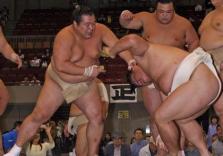
(Source: Sponichi)
The yokozuna had eleven fights. Girthed by his tsuna, eight meters long and weighing twenty-two kilos (kesho-mawashi included), and assisted by Aminishiki and Ryuo, he also performed a dohyo-iri that was greeted enthusiastically by the public.
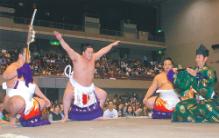
(Source: Kanagawa Shimbun)
In the end, the sole apparent consequence of Tokitaizan's tragic death was the cancellation of the usual butsukari-geiko session. Nonetheless, Oshima oyakata, Nihon Sumo Kyokai official in charge of tours, denied the connection: "The dohyo was not well prepared for the session. If the conditions had been good we would have held one." He clearly explained his thinking: "There is a difference between abuse and training. To be efficient, training should be harsh. And the tours are a good occasion to show it." For Oshima, what happened to Tokitaizan "wasn't done in training. Training must not be used to carry out a lynching! During this tour there will be butsukari-geiko as usual, and I want to make the audience understand what kawaigari really is."

(Source: Mainichi)
On this inaugural day, it seemed that organizers could hope for excellent ticket-sales for the next twelve stops of this autumn tour.
Friday, October 12th - Narita basho
Sumo is a sport under surveillance. On Friday, October 12th, Kenshiro Matsunami, vice-minister of education, culture, sports, research and technology (Monbusho, ministry in charge of sumo) observed the morning training. Mr Matsunami, known among other things by his ponytail, came to familiarise himself with sumo training methods: "With this affair in Tokitsukaze beya, I had to know what the real conditions in training were like." After observing the wrestlers for about two hours, he expressed his impressions: "If we compare makushita, juryo and makuuchi divisions, the builds of wrestlers are very different. Couldn't it be that the oyakata do unreasonable things to the wrestlers to make them advance?" He wishes that "the oyakata had more opportunities to increase their knowledge on training methods, nutrition, doping and humanity (!!!)" and that studies in those subjects would be organised. The vice-minister also spoke of the new Tokitsukaze oyakata, who had started this tour as maegashira Tokitsuumi: "The fact that he immediately went to visit the young, departed deshi's family gives a rather positive impression of him as human being."

Kenshiro Matsutani in the center (Source: Mainichi)
As Oshima oyakata had promised, 4000 persons around the dohyo, who came to Narita municipal gymnasium, could again watch butsukari-geiko sessions. Hakuho and Yoshikaze gave notable demonstrations.

Hakuho-Yoshikaze (Source: Yomiuri)
There was also the return of Kotomitsuki, briefly hospitalised earlier in the month because of abdominal pains and absent on the first day, who was greeted enthusiastically by the audience: "I am still not completely recovered but it is better for my mood that I get out a bit. I reckon I will begin training next week. I will visit the hospital, and if everything is all right I will get cracking again. Between now and then I will take things slowly." The ozeki intends to participate on the 14th, a highpoint of this tour that will take place in Kokugikan.
Saturday, October 13th - Tsuchiura Ushiku basho
The previous tour transformed into an operation of charming the public into forgetting yokozuna Asashoryu's escapades. This tour had to rehabilitate certain sumo practices, discredited by Tokitaizan's death. And once again it was Hakuho that Nihon Sumo Kyokai is counting on. In front of 4000 spectators gathered in Tsuchiura Centre for Culture and Sport, Kisenosato had the privilege to be chosen as the yokozuna's "favourite" in order to demonstrate "true" kawaigari. The two men started with a dozen training bouts, and followed that with six minutes of butsukari-geiko. Hakuho, not paying any attention to Kisenosato's fatigue, played the wall, and rolled his opponent to the right or left, occasionally throwing water in his face to motivate him.

Hakuho-Kisenosato (Source: Sponichi)
Kisenosato wasn't chosen at random: in fact, he comes from neighbouring city of Ushiku, associated with this basho for his sake. About one thousand of the spectators had come from that city. And yet, none of them was offended by such treatment of the local hope. Hakuho said that was "utterly ordinary. It is exactly because we place hopes on him (Kisenosato) that I lent him my chest. In the future I will do the same with other promising youngsters." Oshima oyakata repeated his credo again: "Without severity, we cannot produce strong rikishi. True fans surely understand that." Kisenosato was also satisfied: "It was a good training session."
The last visit of a Nihon Sumo Kyokai tour to Tsuchiura was back in February 2004, five and a half years ago. During the morning, the public's appetite was whetted by the mame-rikishi ("budding rikishi", children who practice sumo), shokkiri (comic sumo performance) and sumo jinku. Coming next were the dohyo-iri of the rikishi and yokozuna. Kisenosato and Miyabiyama, who was born in Mito, capital of Ibaraki prefecture situated north of Tsuchiura, received a lot of applause. Kisenosato didn't hide his joy in participating in his first home tour: "I have felt the warmth of the audience of my own region. [...] I am very glad; I have received a lot of encouragement. In the next tournament I will do my best to repay the attention of all these people."
One hundred and twenty wrestlers then participated in the day's bouts, from jonidan debutants to the yokozuna. For the greater pleasure of the spectators, Kisenosato defeated Kotomitsuki by yorikiri and Miyabiyama dominated in his bout against Ama from the beginning to the end. He put the pressure on the Mongol from the tachi-ai and finally got the better of him by a tsukidashi.
Sunday, October 14th – Kokugikan
On Sunday, October 14th, an exhibition tournament in which thirty-nine makuuchi rikishi participated took place in Kokugikan. Sponsored by "Hochi Shimbunsha", a publishing house from the Yomiuri group, it had a 2,500,000 yen (a bit over 15,000€) award prize.
The logical favourite in the absence of the other yokozuna, Hakuho indeed finished as winner, for the second consecutive time. "It is different from official tournaments; there are several bouts in one day. The body gets really warm and that's good training", the champion declared, before asking his tsukebito: "All right, shall we all go eat something now?"

(Source: Hochi)
Hakuho, who vows to love these one-day tournaments, participated starting from the third round. In the semi-finals, he defeated Kisenosato by sotogake. In the finals he defeated Roho by yorikiri, after making sure of a solid left-side grip on the mawashi. The yokozuna appeared in an unfamiliar dark brown mawashi: "I intend to use it in official tournaments starting from Hatsu basho. Does it suit me?" Was this a particular reference addressed to his colleague yokozuna Asashoryu, who is also supposed to return to the dohyo in Hatsu basho?
The attention was also focused on Toyonoshima, who probably still felt exposed. Anxious to appear in good form, the maegashira from Tokitsukaze defeated the Mongolian Ryuo in the first round, and Tamanoshima, in the second. The much expected third round pitted him against Aminishiki, another Aki basho hero. Toyonoshima won the bout by yorikiri. The wind then turned against him and he succumbed in the quarter-finals to Hakuho. Having received much support from the audience, Toyonoshima was nonetheless satisfied, especially considering the pressure of the current difficulties in his heya on the quality of his training. He gave his all without calculation and intends to do the same in the Kyushu basho.

(Source: Hochi)
Performance of the ozeki was less splendid. Kotooshu, the best among them, didn't advance past the quarter-finals. Kaio was absent because of pain in his left thigh. Kotomitsuki, on the other hand, was present, perhaps unreasonably since the causes of his abdominal problems were still not identified.

Ozeki and mame-rikishi (Source: Hochi)
Saturday, October 20th - Kashihara basho
This fifth day marked the beginning of the last part of the autumn tour. In nine stages, the tour would cross the south of the main island of Japanese archipelago, and also stop for two days on Shikoku island.
It has been seven years since the wrestlers came to Kashihara, in Nara prefecture. 3600 spectators came to the city park gymnasium, almost full and with a very enthusiastic atmosphere. Various objects signed by the rikishi were put on auction for a charity sale.
Hakuho had fifteen training bouts against Kisenosato and Toyonoshima. Dominating, he won fourteen of them: "I love the tours. In anticipation of the Kyushu basho, I will carry on very seriously."

(Source: Hochi)
On this Saturday, the true cause of Kotomitsuki's health problem also became known. The examination held on the 16th finally revealed the presence of gallstones, which were probably the cause of abdominal pains the ozeki suffered from since the start of October. "I should have these stones removed some day or another. But from now until the Kyushu basho, I feel obliged to continue while watching my condition." A surgical intervention is in fact possible after the next tournament. While waiting, Kotomitsuki is being subjected to medical treatment and also to diet restrictions that prevent his training. "I myself can feel my body getting weaker" he said, aware that he is in a critical situation as his second tournament as an ozeki approaches.
Sunday, October 21st - Kobe basho
On Friday October 19th, 250 members of the tour, rikishi and supporting staff, disembarked in Kobe airport. From the moment their massive forms appeared in view, cries of welcome were heard: in the arrival hall, seventy-two kindergarten children were gathered to greet them. The children gave a bouquet to Chiyotaikai and sang, did shiko and threw salt.

(Source: Asahi)
Two days later, the big men met the Kobe public in the municipal gymnasium in Chuo ward. The morning training started at 8:00 AM and the bouts at 1:00 PM.

Tochiozan-Hakuho (Source: Daily Sports)
During the six minutes of butsukari-geiko that wrapped up the training, Hakuho took care of Tochiozan. Treated without pity by his senior, the Japanese quickly found himself stained with sand. The two men are only two years apart, but one is still a young hope while the other is already yokozuna. And as such, he takes his mentoring duties towards his juniors very seriously.
Monday, October 22nd - Miyajima basho
The preparation of the dohyo that would receive the seventh stop of the tour had started on the previous Saturday. On that day, the Nihon Sumo Kyokai employees and volunteers from local associations of sumo fans erected the base on the grounds of Miyajima primary school. Ten tons of local sand, earth and cement were used. The tawara were laid on the next day.

(Source: Chugoku Shimbun)
A national treasure to host the national sport: such was the day in the city of Miyajima, on the island of Itsukushima, Hiroshima prefecture.
Itsukushima Island, sometimes called Miyajima Island, is located south of the main Japanese island, just between it and the island of Shikoku. It is an island sacred to the Shinto religion. As such, it is forbidden to be born or to die there, and there is no maternity ward or cemetery on the island. On the other hand, a number of temples had been constructed. The main temple is the temple of Itsukushima, particularly known for its floating torii (portal marking the entrance to a temple), one of the most famous views in Japan, listed as a World Heritage Site by UNESCO since 1996.
It was in this prestigious frame, and a symbolic one for a sport connected to Shinto, that Hakuho could enjoy one of the privileges of a yokozuna. He performed his dohyo-iri in the temple grounds, on the Takabutai (a stage usually reserved for Bugaku performances, traditional court dances), with the floating torii in the background.

(Source: Yomiuri)
In front of 1500 people, the Mongolian seemed calm but he was aware of the moment: "You could see the sea - that was good. Only the yokozuna can perform dohyo-iri in similar places. I felt once more what it means to have this title." This was the first time that a Nihon Sumo Kyokai tour had stopped at Miyajima and the first time that a dohyo-iri was organised in the temple of Itsukushima.
The other rikishi, more than hundred of them, had their dohyo-iri later, in the Miyajima primary school in front of 3500 spectators. As is customary, the local wrestlers, among them Kitazakura, who comes from city of Hiroshima, were greeted particularly warmly by the audience, which was once more delighted: "It was worth the trouble and taking one day of vacation to come here. Sumo in a sacred place, that is really beautiful." "This is the first time that I am watching sumo. From jonokuchi to yokozuna, the body size changes progressively. It is interesting to see such an unusual world. I hope they will return next year."
Tuesday, October 23rd - Imabari basho
On the next day, the jungyo was held just a few miles off Miyajima, on Shikoku Island. Hakuho again performed a dohyo-iri in the open, this time in a park in Imabari, city in the north of Ehime prefecture. It has been 46 years since a tour made a stop there, and according to organizers, 2000 people watched the event.
In the afternoon, 3000 spectators were present in the municipal gymnasium, most notably to encourage maegashira Tamakasuga, native of Seiyo in the south of Ehime prefecture: "It is really very pleasant to climb on the dohyo at my home. I am delighted that I could make everyone happy."
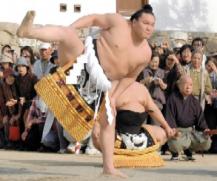
(Source: Asahi)
Wednesday, October 24th - Uwajima basho
The atmosphere on the dohyo wasn't so calm in Uwajima, the second and last day on Shikoku. The young Russian Wakanoho, who among other things was assured of promotion to makuuchi for the Kyushu basho, let himself go and acted violently. During a training bout, as he was being pushed out of the dohyo by Chiyohakuho, Wakanoho knocked him on the ground with a strike to the back of his head. The atmosphere between the two men was tense, but around the dohyo, the oyakata were watching carefully and warned them. Wakanoho ("He continued to push me after I was out, so I got annoyed. Starting from now, I will fight within the rules."), finally apologised to Chiyohakuho ("He apologizes, it's finished.") It seemed that Oshima oyakata was more inclined to leniency towards the young Russian than towards Chiyohakuho, five years his senior. Nevertheless, after the series of Asashoryu's misdemeanours, the behaviour of foreign rikishi has become a subject with which one does not trifle.

(Source: Hochi)
Thursday, October 25th - Higashihiroshima basho
Higashihiroshima is famous for its sake production and hosts the National Institute of Brewing from 1995. It is also a university city. In spite of these diverse charms, less than a week before the basho, the ticket sales were not the best. From 4800 at the start, the predictions of the organizers dropped to 2700: "The scandals in sumo do not stop, but there is still time. We hope for a good final dash." The former sekiwake Akinoshima (Sendagawa oyakata, Takadagawa), native of Hiroshima prefecture, also preferred to remain optimistic: "The world of sumo is passing through great challenges. That said, we hope that the sales will increase, so that in the end we can call this a success."
This optimism wasn't unreasonable, since on tournament day, more than 4000 spectators gathered in Higashihiroshima City Gymnasium, creating a very heated atmosphere.
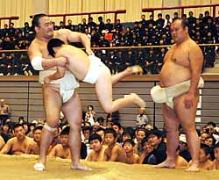
(Source: Chugoku Shimbun)
This fevered crowd would watch Wakanoho pay the price of his ill-considered act the day before. In fact, it was his compatriot Hakurozan who put himself in charge of Wakanoho's education. He made his mind clearly known ("The mood of the rikishi should be the same, regardless whether he wins or loses!") and subjected Wakanoho to a kawaigari session. Hakurozan recalled that in his time, he was lucky to be taken in hand by Kitazakura and Tochinonada during a tour: "Now I am passing this education on to Wakanoho." Faced with such concern for himself, the young hothead expressed his gratitude and promised to return to the right path. And the skeptics wondered if Hakurozan was as much occupied with the education of his own brother.

(Source: Hochi)
Kokkai is now wearing sideburns in form of rectangular triangle. After appearing in a more modest form during Aki basho, they grew longer and the Georgian was counting on them to help him out of the make-koshi spiral he suffered for last three tournaments: "I will also go to Kyushu basho like this. I want to do anything to get a kachi-koshi!" he joked.
Friday, October 26th - Izumo basho

(Source: Sanin Chuo)
Starting from October 22nd, in Izumo, at the very north of Shimane prefecture, you couldn't help notice that the rikishi would be passing through the city after two years of absence. To announce that appearance, nobori (vertical flags) in bright colours were hung out around Izumo Dome where the festivities would take place. In the style characteristic to sumo, on the flags were written the shikona of the wrestlers but also encouragement to the rikishi from the prefecture, among them to Kotootori (sandanme, Sadogatake) from the city of Izumo itself, and to Fukuoka (makushita, Hakkaku).
Upon the arrival of the troupes to Izumo on the evening of the 25th, the yobidashi already took care of building the dohyo, the seats around the dohyo and the stands. Once finished, they prayed for good progress of the basho and purified the dohyo with sake.

(Source: Sanin Chuo)
Saturday, October 27th - Masuda basho
The last weekend of the tour began at Masuda Sakura Dome, in front of 3000 people. About twenty children from kindergarten and primary school have come to challenge the rikishi. As is usual, they had the fun of being whirled through the air. The hero of the day was Katsuya Wazaki, nine years old, who brought down Kitazakura.

(Source: Chugoku Shimbun)
Sunday, October 28th - Yamaguchi basho
On the next day, the last day of this autumn tour, the other audacious boys challenged, in particular, Homasho and Toyohibiki, both natives of Shimonoseki in the west of Yamaguchi. The city hadn't hosted a tour for seven years and 4000 viewers came to watch at the local Centre of Culture and Sport.
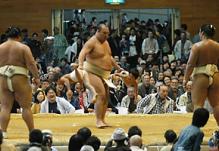
(Source: Chugoku Shimbun)
On the same day in a city hotel, before 270 fans, Homasho participated in the inauguration of his supporter association from Shimonoseki.
Programme of the Izumo basho
8:00 - Opening, autograph signings, public training
10:30 - Children's sumo
10:50 - Sumo jinku performance by Sumo jinku association of Izumo
11:00 - Jonidan, sandanme, and makushita bouts
12:15 - Introduction of rikishi native to the region
12:30 - Shikkiri, sumo jinku, taiko
13:00 - Juryo dohyo-iri, mage-making demonstration
13:10 - Juryo bouts, tsuna-tying demonstration
13:50 - Makuuchi and yokozuna dohyo-iri
14:00 - Introduction of executive committee
14:10 - Makuuchi bouts
14:55 – Bow-twirling ceremony
15:00 - Closing